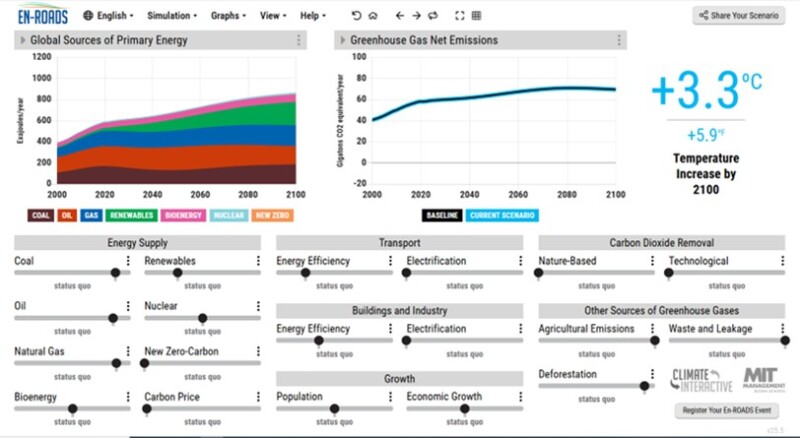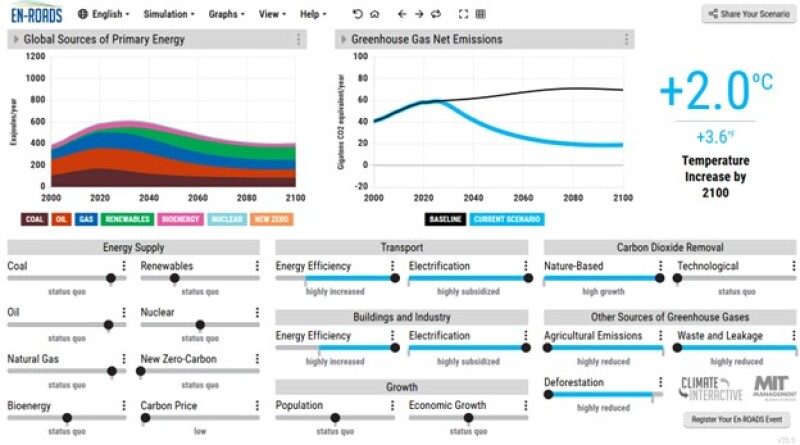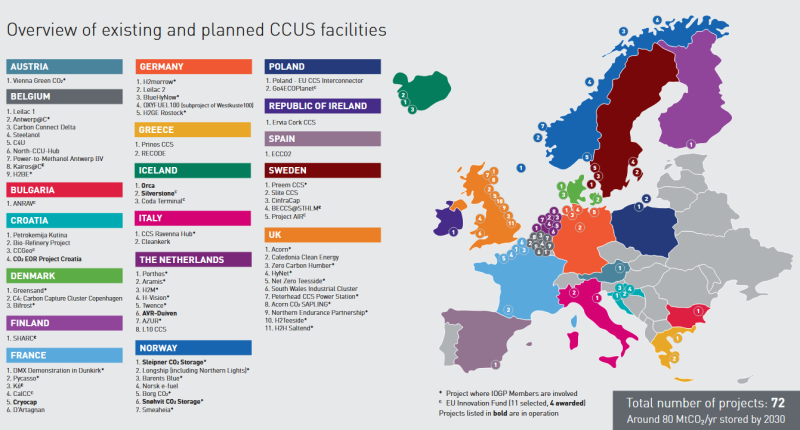The global energy landscape is undergoing an unprecedented transformation, driven by the urgent need to address climate change and transition to a sustainable future. For young professionals in the energy sector, understanding the complexities of this transition is not just an academic exercise, it is a professional imperative. In this context, tools that foster a holistic understanding of climate dynamics and empower informed decision-making are invaluable. One such tool is the En-ROADS Climate Solutions Simulator.
System Thinking in Current Energy Framework
The science is clear: Limiting global warming to "well below 2°C above pre-industrial levels and pursuing efforts to limit the temperature increase to 1.5°C," as committed to in the Paris Agreement, requires a rapid and profound global shift. This is not just about reducing emissions from one sector; it is about transforming the entire energy system.
However, complex systems are notoriously difficult to navigate. Decisions made in one area can have unforeseen ripple effects across others, sometimes leading to unintended consequences or diminishing returns. For instance, boosting renewable energy is vital, but without concurrent efforts in energy storage, grid modernization, and demand-side management, its full potential may be hampered. Similarly, focusing solely on emissions reductions from electricity generation might overlook the substantial contributions from industrial processes or agriculture.
This is where a systems thinking approach becomes invaluable. It encourages us to look beyond isolated problems and consider the interactions among factors such as energy supply, energy demand, land use, population growth, economic development, and technological innovation. En-ROADS (Energy Rapid Overview and Decisions Support), developed by Climate Interactive and MIT Sloan, was specifically designed to facilitate this exact kind of holistic understanding.
Decoding the Climate-Energy System With En-ROADS
At its core, En-ROADS is a free, user-friendly, and scientifically grounded simulator that allows anyone to explore how different energy and climate policies can influence global temperature by 2100. It is built on a system dynamics model, meaning it accounts for delays, feedback, and nonlinear relationships inherent in complex systems.
Imagine a highly interactive dashboard where you can adjust sliders representing various climate solutions (Fig. 1)—including energy supply options such as coal, oil, natural gas, renewables, and nuclear and factors affecting energy demand such as electrification, energy efficiency, and population and GDP growth. It also includes carbon removal strategies such as afforestation and direct air capture, as well as other emissions sources such as methane, nitrous oxide, and land-use change.

As the sliders are moved, En-ROADS instantaneously updates key outputs, visually demonstrating the effect on several important metrics. These include global temperature rise—perhaps the most critical indicator—showing projected warming by 2100; net greenhouse gas (GHG) emissions, highlighting the forecasted trend compared to the reference case; and the energy mix, revealing the evolving shares of different energy sources. Other key indicators include potential effects on economic growth, ocean acidification, sea level rise, and the frequency and intensity of extreme weather events, as well as the population exposed to those threats.
This systemic vision is transformative. It allows everyone to debunk myths, gaining a data-driven understanding of why certain large-scale actions might have limited overall effect or vice versa.
En-ROADS is not a prediction tool; rather, it is a powerful learning and decision-support simulator. It is calibrated against a wide range of models used by the Intergovernmental Panel on Climate Change, the International Energy Agency, and the International Institute for Applied Systems Analysis, ensuring scientific robustness while maintaining accessibility.
The Imperative for a Portfolio of Solutions
One of the more profound insights from En-ROADS is the clear demonstration that there is no single silver bullet to solve the climate crisis. No individual policy or technology, no matter how impactful, can achieve the Paris Agreement goals in isolation. Instead, deep decarbonization requires a systemic approach, a portfolio of solutions implemented simultaneously and at scale.
For instance, significantly scaling up renewable energy—such as solar and wind—is fundamental. However, even maximizing renewables alone often does not bring warming down to 1.5°C in En-ROADS. To achieve that goal, this strategy typically needs to be combined with aggressive energy efficiency improvements that reduce overall energy demand across buildings, industry, and transport; widespread electrification, shifting vehicles, heating, and industrial processes from fossil fuels to electricity; targeted reductions in methane and nitrous oxide, two powerful non-CO2 GHGs often linked to agriculture and fossil fuel operations; and finally, halting deforestation while promoting afforestation to protect and expand natural carbon sinks (Fig. 2).

Only when a robust combination of these levers is pulled does the temperature curve bend effectively toward the Paris Agreement targets. This systemic understanding is vital for energy professionals, highlighting the need for cross-sector collaboration and integrated strategies rather than siloed efforts.
How En-ROADS Models CCS
The En-ROADS simulator offers the opportunity to explore the role of carbon capture and storage (CCS) in addressing climate change. While CCS has potential, its simulated contribution to global temperature reduction by 2100 often appears modest. This is primarily because of the vast scale of global emissions, the inherent inertia of our energy systems, and the significant costs and limitations associated with deploying CCS widely.
For example, with reference to CCS associated with natural gas, a global subsidy of $85 per ton, mirroring the US Inflation Reduction Act's tax incentive, leads to substantial industry growth (around 15% annually) but still captures only a modest portion of overall natural gas emissions.
This is partly because natural gas CCS is applicable to only about 90% of electricity generation, 80% of industry, and has an 80% capture rate. Furthermore, the cost of CCS does not drop significantly over time because of a modest progress ratio of 0.95, meaning only a 5% cost improvement for every doubling of installed capacity (Iglesias 2025). This is because of its high design complexity and customization needs.
Finally, the capture process itself consumes energy, often generated by fossil fuels. While minor, this somewhat offsets the benefits. Also, by making natural gas cheaper (e.g., through subsidies), CCS can inadvertently lead to more overall gas demand and production, which can increase methane emissions. This highlights a complex interplay where the benefits of capturing CO2 can be partially offset by other effects within the broader energy system.

These natural gas CCS parameters, along with many others throughout the simulation, can be easily adjusted. This flexibility is a significant advantage of the En-ROADS model, enabling users to analyze alternative scenarios. It empowers deeper understanding of how different policy decisions and technological advancements could shape our future.
In essence, En-ROADS suggests that, while CCS is a useful tool, it is not a standalone solution. CCS can support these efforts in specific, hard-to-abate sectors, but it cannot solve the climate crisis on its own.
Conclusion
The climate crisis demands a pragmatic, comprehensive, and scientifically informed response. The En-ROADS simulator offers a powerful platform to explore this challenge, revealing the interconnectedness of global systems and the need for a diverse portfolio of solutions. Within this portfolio, CCS emerges not as a standalone panacea, but as an indispensable technology, particularly for decarbonizing hard-to-abate sectors and achieving the necessary negative emissions.
Young professionals in the energy sector have a unique opportunity and responsibility to lead this transition. By leveraging tools such as En-ROADS, embracing systems thinking, and championing the strategic deployment of clean technologies, we can collectively work toward a future that meets the Paris Agreement targets and ensures a sustainable planet for us and generations to come.
Opinions in the article are personal and cannot be referred to the company the author works for.
For Further Reading
Carbon Capture and Storage (CCS) in En-ROADS by C. Iglesias, Climate Interactive
The Paris Agreement, United Nations Climate Change


